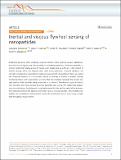Notice
This is not the latest version of this item. The latest version can be found at:https://dspace.mit.edu/handle/1721.1/136163.2
Inertial and viscous flywheel sensing of nanoparticles
| dc.contributor.author | Katsikis, Georgios | |
| dc.contributor.author | Collis, Jesse F | |
| dc.contributor.author | Knudsen, Scott M | |
| dc.contributor.author | Agache, Vincent | |
| dc.contributor.author | Sader, John E | |
| dc.contributor.author | Manalis, Scott R | |
| dc.date.accessioned | 2021-10-27T20:31:11Z | |
| dc.date.available | 2021-10-27T20:31:11Z | |
| dc.date.issued | 2021-12 | |
| dc.identifier.uri | https://hdl.handle.net/1721.1/136163 | |
| dc.description.abstract | <jats:title>Abstract</jats:title><jats:p>Rotational dynamics often challenge physical intuition while enabling unique realizations, from the rotor of a gyroscope that maintains its orientation regardless of the outer gimbals, to a tennis racket that rotates around its handle when tossed face-up in the air. In the context of inertial sensing, which can measure mass with atomic precision, rotational dynamics are normally considered a complication hindering measurement interpretation. Here, we exploit the rotational dynamics of a microfluidic device to develop a modality in inertial sensing. Combining theory with experiments, we show that this modality measures the volume of a rigid particle while normally being insensitive to its density. Paradoxically, particle density only emerges when fluid viscosity becomes dominant over inertia. We explain this paradox via a viscosity-driven, hydrodynamic coupling between the fluid and the particle that activates the rotational inertia of the particle, converting it into a ‘viscous flywheel’. This modality now enables the simultaneous measurement of particle volume and mass in fluid, using a single, high-throughput measurement.</jats:p> | en_US |
| dc.language.iso | en | |
| dc.publisher | Springer Science and Business Media LLC | en_US |
| dc.relation.isversionof | 10.1038/s41467-021-25266-3 | en_US |
| dc.rights | Creative Commons Attribution 4.0 International license | en_US |
| dc.rights.uri | https://creativecommons.org/licenses/by/4.0/ | en_US |
| dc.source | Nature | en_US |
| dc.title | Inertial and viscous flywheel sensing of nanoparticles | en_US |
| dc.type | Article | en_US |
| dc.relation.journal | Nature Communications | en_US |
| dc.eprint.version | Final published version | en_US |
| dc.type.uri | http://purl.org/eprint/type/JournalArticle | en_US |
| eprint.status | http://purl.org/eprint/status/PeerReviewed | en_US |
| dc.date.updated | 2021-09-07T18:07:08Z | |
| dspace.orderedauthors | Katsikis, G; Collis, JF; Knudsen, SM; Agache, V; Sader, JE; Manalis, SR | en_US |
| dspace.date.submission | 2021-09-07T18:07:09Z | |
| mit.journal.volume | 12 | en_US |
| mit.journal.issue | 1 | en_US |
| mit.license | PUBLISHER_CC | |
| mit.metadata.status | Authority Work and Publication Information Needed | en_US |
| mit.metadata.status | Authority Work and Publication Information Needed |
